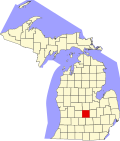East Lansing | |
|---|---|
| City of East Lansing | |
Downtown East Lansing | |
 Location within Clinton County (top) and Ingham County (bottom) | |
| Coordinates: 42°44′53″N84°29′01″W / 42.74806°N 84.48361°W | |
| Country | United States |
| State | Michigan |
| Counties | Clinton and Ingham |
| Settled | 1847 |
| Incorporated | 1907 |
| Government | |
| • Type | Council–manager |
| • Mayor | George Brookover |
| • Manager | Robert Belleman |
| Area | |
• Total | 13.51 sq mi (35.00 km2) |
| • Land | 13.43 sq mi (34.79 km2) |
| • Water | 0.081 sq mi (0.21 km2) |
| Elevation | 856 ft (261 m) |
| Population (2020) | |
• Total | 47,741 |
| • Density | 3,554.4/sq mi (1,372.37/km2) |
| Time zone | UTC-5 (EST) |
| • Summer (DST) | UTC-4 (EDT) |
| ZIP code(s) | |
| Area code | 517 |
| FIPS code | 26-24120 [3] |
| GNIS feature ID | 1626207 [2] |
| Website | www |
East Lansing is a city in the U.S. state of Michigan. Most of the city lies within Ingham County, although a small portion extends north into Clinton County. At the 2020 census, the city had a population of 47,741. [4] The city is located immediately east of Lansing, Michigan's capital and sixth most populous city. Both cities are part of the Lansing–East Lansing metropolitan area.
Contents
- History
- Geography
- Description
- Neighborhoods
- Demographics
- 2010 census
- 2000 census
- Government
- Education
- Higher education
- Public primary and secondary schools
- Private schools
- Transportation
- Local transportation
- Intercity transportation
- Major highways
- Culture
- Centennial
- Sites of interest
- On campus
- Off campus
- Outside East Lansing
- Newspapers
- Local events
- Notable people
- Notes
- Further reading
- External links
East Lansing is a college town, and is home to Michigan State University (MSU), one of the largest public universities in the United States. The city is economically and demographically dominated by MSU.












